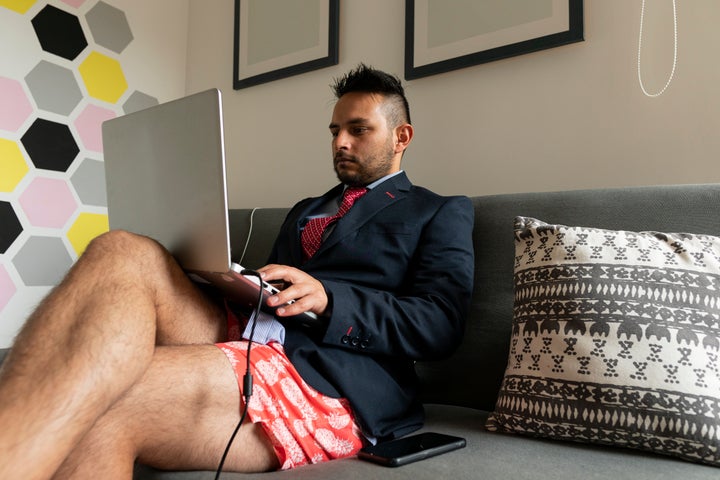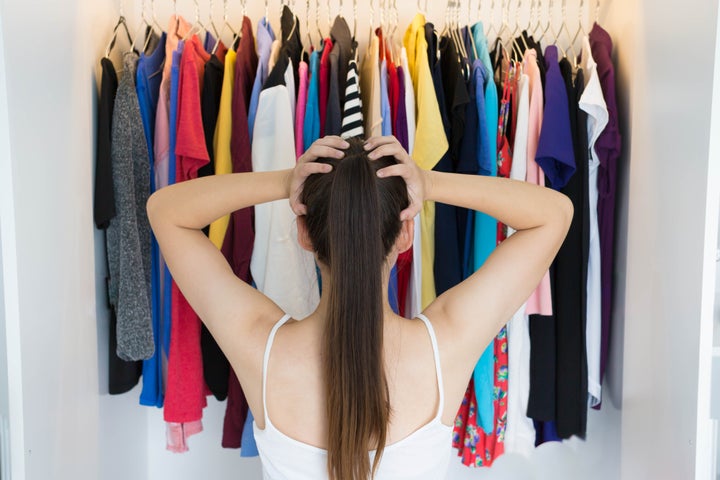
After nearly a year of sheltering in place, even the most polished among us have shifted to a lower-maintenance appearance. Our makeup and hairstyling routines have been downgraded to the bare minimum, if not eliminated altogether. Our pants have been traded for matching athleisure sets and pajamas paired with college sweatshirts. Coincidentally, our mental health is also on the decline — and it’s possible there’s a correlation between the two.
Psychologists believe that even when we aren’t presenting ourselves to the public, how we dress has the power to influence our mental health and general productivity. But depending who you are, dressing up can affect you in a positive or negative way. The actual impact of getting dressed up or down varies from person to person, experts said.
“For a lot of us, there’s an internal message of ‘I care about myself,’ and that’s going to look differently for different people,” Donna Novak, a licensed psychologist in Simi Valley, California, told HuffPost.
The case for dressing up, even just a little
Tracy Thomas, an emotional scientist, psychologist and interventionist, calls putting effort into our appearance ― even if it’s just the tiniest bit ― “one of the most important things people can do for their emotional, mental and psychological health.” She likens daily grooming rituals to “celebrating life” and believes such celebrations are especially important right now, when people are spending more time dwelling on the negative.
“If you’re dazzling and sparkling, even if it’s just putting on a necklace with your tracksuit, you actually will feel more dazzling and sparking in life,” Thomas told HuffPost.
The behavioral act of getting dressed can have a significantly positive impact on our mood, confidence and behaviors, according to Sheva Assar, a licensed clinical psychologist in Orange County, California. She believes the act of getting dressed up first thing in the morning may “increase our motivation to do other things throughout the day, to experience more energy and to want to do more things.”
“It gets us out of the cycle of staying in that place of inaction,” she told HuffPost.
Assar suggests that people not only consider the aesthetics, but how each look corresponds with their agenda for the day, and plan accordingly. Given that many people are sheltering at home, those with multiple appointments might want to change up their look to draw boundaries that help separate one activity from the next.
“If we’re wearing athleisure when working out, going to brunch, outside and when working, it could potentially impact our ability to transition into work mode when we’re wanting to focus on work. So what we’re wearing helps us in making those transitions,” Assar said.
Creative types in particular might feel the emotional benefits of their wardrobe more than non-creative people, Thomas said.
“Typically, the people who would have the most struggle with emotional issues are also the people who need to create. And if you’re not creating every day — including creating your own self with your different wardrobe and the way [you] adorn and decorate yourself — you’re essentially taking away part of your creative process and then that can create sadness and depression,” Thomas said.
Even those who don’t have work or other clearly defined activities to break up their day will find it harder to feel productive and confident without some sort of morning grooming ritual, Novak said.
Just as getting dressed up on a regular basis can elevate our mood and influence our behaviors, dressing down too often can create similar long-term negative effects.
“Human beings really need the aesthetics of life to be good in order to have an elevated mood,” Thomas said, adding that those who underdress regularly can become “less and less productive because you’re not really celebrating your life.”
The case for staying in your sweatsuit
While experts agree that most people will see benefits from putting daily care into their looks, some acknowledge that there can be drawbacks. People who struggle with body image, for instance, may find getting dressed to be a distressing and unpleasant experience.

Some people might even see a decrease in productivity if they spend too much energy trying to amp up their look.
“If you’re spending way too much time thinking about what to wear, it’s getting in the way of you showing up more fully,” Assar said.
San Francisco-area clinical psychologist Wayne Pernell agreed, saying, “A lot of people will dress up and show off that they’re dressed up, but they’re not productive.”
Instead of emphasizing glamour, Pernell urged everyone to consider how their appearance is helping them get closer to their goal.
He pointed to Steve Jobs’ signature black turtleneck and blue jeans as an example of how less investment in one’s appearance can boost both creativity and productivity.
“His uniform was picked out so that he didn’t have to ever make a decision about what to wear,” Purnell said. “He was always going to wear the same thing. That left his decision-making for the important things during his day.”
For those who are creative, “if you can dress down and be casual a lot of times, that actually boosts creativity,” he said. “If you think about the times you are most creative, you are most creative in the shower and you’re most creative out on a walk. And neither of those are when you’re dressed up.”
Pernell has little faith in the belief that dressing up makes casual everyday activities feel more glamorous, saying, “You can train yourself to be casual [wearing] anything.”
Instead of concentrating on flashy looks, he suggests focusing on intentionality.
“If your intentionality slips, no amount of dressing up is going to bring that back,” he said. “It is about mindset, and your clothing reinforcing the mindset. And your mindset is what makes all the difference in your productivity.”
Baby steps
If you want to boost your personal aesthetic in hopes of elevating your mood and optimizing productivity, start with a vision for yourself and identify one small thing you can do.
Novak recommends beginning by giving yourself time each morning “to be present with your closet.”
“Taking it slow and having time for yourself in that process is probably the most important thing,” she said.
Ask yourself what would make you feel comfortable and good that day rather than letting anxiety or worries drive you to pick something really quickly.
Most importantly, remember to always pick clothing and grooming practices that make you feel the most confident and comfortable. So basically, figure out what makes you feel good, and you do you.